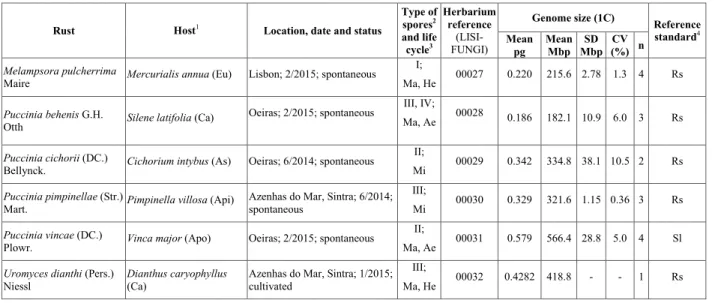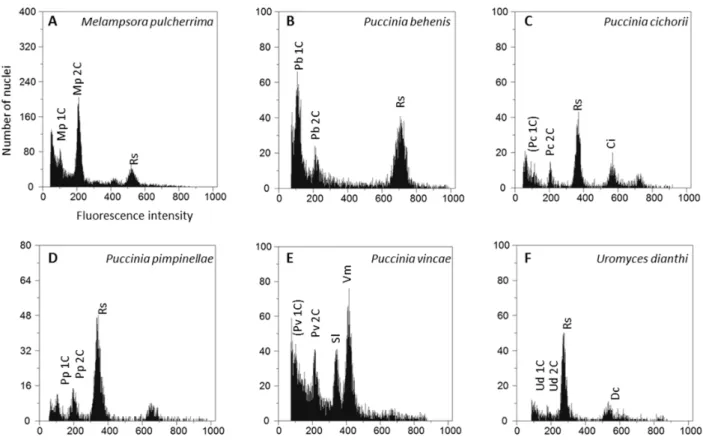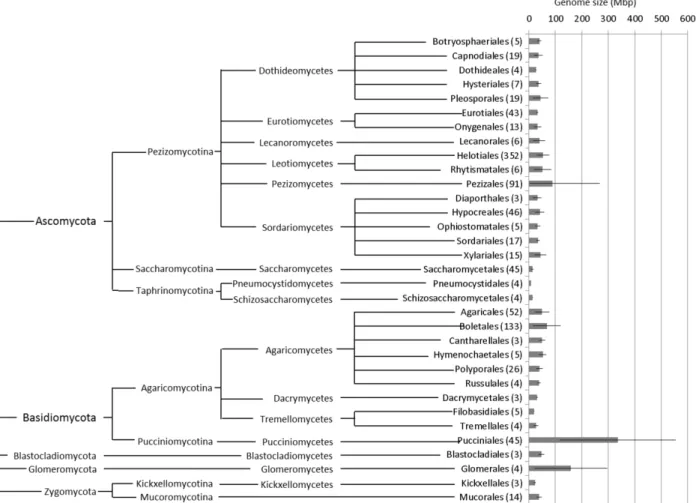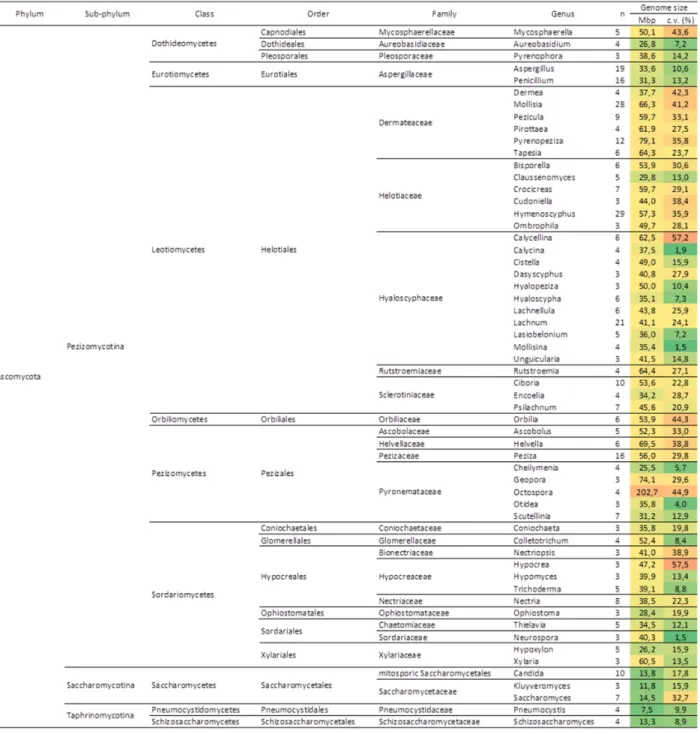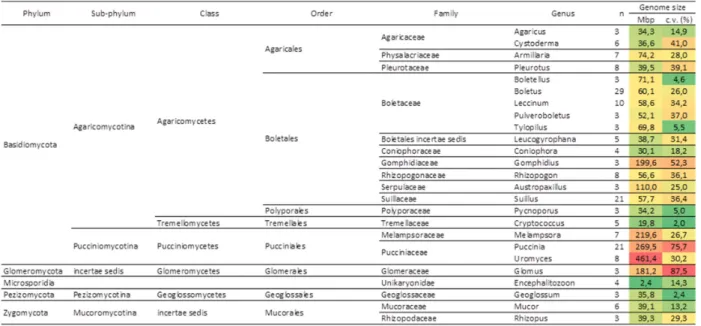Genome size estimates for six rust (Pucciniales) species
Estimativa do tamanho do genoma de seis espécies de ferrugens
(Pucciniales)
Pedro Talhinhas
1,2, Ana Paula Ramos
2, Daniela Tavares
3, Sílvia Tavares
1*and João Loureiro
3 1 Centro de Investigação das Ferrugens do Cafeeiro, BioTrop, Instituto de Investigação Científica Tropical, 2780-505 Oeiras, PortugalE-mail: *sagtavares@gmail.com, author for correspondence
2 LEAF-Linking Landscape, Environment, Agriculture and Food, Instituto Superior de Agronomia, University of Lisbon, 1349-017 Lisboa, Portugal 3 CFE, Centre for Functional Ecology, Department of Life Sciences, University of Coimbra, 3001-401 Coimbra, Portugal.
Received/Recebido:2015.02.28 Accepted/Aceite: 2015.05.19 R E S U M O
Os fungos que causam ferrugens caraterizam-se pela especialização relativamente ao hospedeiro, pela biotrofia, por possuírem ciclos de vida complexos e grandes genomas. Neste trabalho a citometria de fluxo foi empregue para de-terminar o tamanho do genoma de seis espécies de fungos Pucciniales (Basidiomycota), Melampsora pulcherrima, Puccinia behenis, P. cichorii, P. pimpinellae, P. vincae e Uromyces dianthi, agentes causais de ferrugem em Mercurialis annua, Silene latifolia, Cichorium intybus, Pimpinella villosa, Vinca major e Dianthus caryophyllus, respetivamente. Com resultados entre 182,1 e 566,4 Mpb/1C, este estudo contribuiu para o conhecimento do tamanho dos genomas na ordem Pucciniales, re-forçando a posição deste táxone como o que engloba os fungos com maior tamanho médio de genoma (335,6 Mpb/1C). Este estudo contribui para uma melhor compreensão dos padrões de distribuição de tamanhos de genoma ao longo da filogenia dos fungos, sugerindo uma ligação entre caraterísticas biológicas e o tamanho do genoma. Em particular, os tamanhos dos genomas de fungos Pucciniales variam fortemente dentro do género, mas também diferem de forma vincada dos genomas de outras ordens em Pucciniomycotina que não Pucciniales, sugerindo que a variação do tamanho do genoma possa ser um elemento ativo na evolução dos agentes causais de ferrugens.
Palavras-chave: citogenómica, citometria de fluxo, ferrugem, Fungi, tamanho de genoma A B S T R A C T
Rust fungi (Basidiomycota, Pucciniales), one of the largest groups of phytopathogenic organisms, are characterised by host specialisation, biotrophy, complex life cycles and enlarged genomes. In this work we have used flow cytometry to determine the genome size of six rust species, Melampsora pulcherrima, Puccinia behenis, P. cichorii, P. pimpinellae, P. vincae and Uromyces dianthi, the causal agents of rust on Mercurialis annua, Silene latifolia, Cichorium intybus, Pimpinella villosa, Vinca major and Dianthus caryophyllus, respectively. With results ranging between 182.1 and 566.4 Mbp/1C, this study has contributed to the knowledge of genome sizes in the order Pucciniales, reinforcing this group as the one with the largest average genome size among fungi, with 335.6 Mbp/1C. By comparing genome sizes and their variability across the fungal kingdom, this study has contributed for understanding the patterns of genome size distribution along the fungal phylogeny, suggesting links between biological specificities and genome sizes. In particular, genome sizes of rust fungi vary greatly within genera, but also differ sharply from other non-Pucciniales orders in the Pucciniomycotina, suggesting that genome size variation may be an active element shaping the evolution of rust fungi.
Introduction
Rust fungi (Basidiomycota, Pucciniales) are responsi-ble for very important plant diseases, namely rusts on cereals, soybean, coffee, poplar, pines, legumes, rose and other ornamental plants. They comprise one of the largest groups of phytopathogenic or-ganisms, most of them with very narrow host ran-ges. Such pathological specialisation into such a wide botanical range of hosts (including mosses, ferns, conifers, monocotyledons and dicotyledons) follows elaborated host-pathogen interaction pat-terns according to the gene-for-gene theory, which in fact was developed based on the flax-rust pa-thosystem. Nutrients are obtained by the fungus from living host plant cells (biotrophy) through specialised feeding structures (haustoria). Rust life cycles are among the most complex in fungi, with up to five different spore types and often requiring two botanically distinct hosts to complete the life cycle (as revised by Fernandez et al., 2013). Rust fungi are also characterised by unusually large genomes (average 334 Mbp, while the overall ave-rage for Fungi is 44.2 Mbp), a trait that may favour adaptation and pathological specialisation (Tava-res et al., 2014).
The genera Puccinia, Uromyces and Melampsora en-compass approximately two thirds of all recogni-sed rust species, comprising the most notorious rust pathogens in temperate regions, such as the agents of cereal, legume and poplar rusts. So far, the average genome size for species of the genus Puccinia is 248 Mbp, ranging widely across 17 spe-cies from 77 Mbp to 806 Mbp, i.e., spanning ne-arly the entire range of genome sizes reported so far for rusts. In fact, at 806 Mbp, P. chrysanthemi is one of the largest fungal genomes ever reported, in opposition to the cereal rusts (P. triticina and P. graminis f. sp. tritici, both at 77 Mbp) which fall among the smallest genomes (Tavares et al., 2014), but still twice as large as the average genome size for fungi. Similarly, the genome size of Uromyces species ranges from 277 (U. rumicis) to 712 Mbp (U. vignae), with an average of 467 Mbp obtained over seven species. Genome sizes known for six species in the genus Melampsora range from 118 (M. larici--populina) to 333 Mbp (M. ricini), with an average of 221 Mbp (Tavares et al., 2014).
Such enlarged genomes found in rusts may be im-portant sources of diversity, particularly in the ab-sence of sexual reproduction, due to the activity
of transposable elements (abundant in these large genomes), and the events leading to genome size variation (namely polyploidisation and chromo-some transfer) are thought to be important factors related with host specialisation and even with spe-cific ‘host genotype-pathogen race’ interactions (Duplessis et al., 2011; Spanu, 2012; Stuckenbrock & Croll, 2014). The knowledge of rust genome sizes, besides being of interest to the field of Mycology, is therefore of relevance to Plant Pathology in parti-cular and to Agronomy in general. In this work we have determined the genome sizes of six species causing rust diseases in ornamentals and weeds, namely M. pulcherrima (Dog’s Mercury rust, on Mercurialis annua), P. behenis (White Campion rust, on Silene latifolia), P. cichorii (Chicory rust, on Ci-chorium intybus), P. pimpinellae (Wild Anise rust, on Pimpinella villosa), P. vincae (Blue Periwinkle rust, on Vinca major) and U. dianthi (Carnation rust, on Dianthus caryophyllus). For that, flow cytometry, the state of the art method for fungal genome size de-termination (D’Hondt et al., 2011), coupled with an optimized protocol for the analysis of biotrophic fungi (Loureiro et al., 2007; Tavares et al., 2014), was applied.
Materials and Methods
Plant material exhibiting rust symptoms were collected in the Lisbon area during 2014 and 2015 (Table 1). Rust species were recognised upon iden-tification of host species and complemented by the examination of spore morphology. Herbarium spe-Herbarium spe-cimens were deposited at the João de Carvalho e Vasconcellos Herbarium (LISI; Lisbon, Portugal). Three samples were collected at the teliosporic sta-ge, two at the urediniosporic stage and one at the aecidiosporic stage (Table 1).
Table 1 - Rust species in this study with reference to the host plant, location, botanical status, collection date, rust life cycle stage and herbarium reference
Table 1 - Rust species in this study with reference to the host plant, location, botanical status, collection date, rust life cycle stage and herbarium
reference
Rust Host1 Location, date and status
Type of spores2 and life cycle3 Herbarium reference (LISI-FUNGI)
Genome size (1C) Reference standard4
Mean
pg Mean Mbp Mbp SD (%) n CV
Melampsora pulcherrima
Maire Mercurialis annua (Eu) Lisbon; 2/2015; spontaneous
I;
Ma, He 00027 0.220 215.6 2.78 1.3 4 Rs
Puccinia behenis G.H.
Otth Silene latifolia (Ca) Oeiras; 2/2015; spontaneous
III, IV;
Ma, Ae 00028 0.186 182.1 10.9 6.0 3 Rs
Puccinia cichorii (DC.)
Bellynck. Cichorium intybus (As) Oeiras; 6/2014; spontaneous
II;
Mi 00029 0.342 334.8 38.1 10.5 2 Rs
Puccinia pimpinellae (Str.)
Mart. Pimpinella villosa (Api) Azenhas do Mar, Sintra; 6/2014; spontaneous
III;
Mi 00030 0.329 321.6 1.15 0.36 3 Rs
Puccinia vincae (DC.)
Plowr. Vinca major (Apo) Oeiras; 2/2015; spontaneous
II;
Ma, Ae 00031 0.579 566.4 28.8 5.0 4 Sl
Uromyces dianthi (Pers.)
Niessl Dianthus caryophyllus (Ca) Azenhas do Mar, Sintra; 1/2015; cultivated
III;
Ma, He 00032 0.4282 418.8 - - 1 Rs
1 Acronyms in brackets refer to host family: Api – Apiaceae; Apo – Apocynaceae; As – Asteraceae; Ca – Caryophyllaceae; Eu – Euphorbiaceae; 2 Type of spores present in sampled material: I – Aeciospores; II – Urediniospores; III – Teliospores; IV – Basidiospores (Laundon, 1967); 3 Typical life cycle: Ma – macrocyclic; Mi – microcyclic; Ae – autoecious; He – heteroecious;
4 Plant reference standards used: Rs – Raphanus sativus (2C = 1.11 pg DNA); Sl – Solanum lycopersicum (2C = 1.96 pg DNA).
1 Acronyms in brackets refer to host family: Api – Apiaceae; Apo – Apocynaceae; As – Asteraceae; Ca – Caryophyllaceae; Eu – Euphorbiaceae; 2 Type of spores present in sampled material: I – Aeciospores; II – Urediniospores; III – Teliospores; IV – Basidiospores (Laundon, 1967); 3 Typical life cycle: Ma – macrocyclic; Mi – microcyclic; Ae – autoecious; He – heteroecious;
4 Plant reference standards used: Rs – Raphanus sativus (2C = 1.11 pg DNA); Sl – Solanum lycopersicum (2C = 1.96 pg DNA).
Rust genome sizes were estimated by flow cyto-metry using a Partec CyFlow Space flow cytometer (Partec GmbH, Görlitz, Germany). For such, nuclei were isolated by simultaneously chopping infec-ted leaves of each sample (lisinfec-ted in Table 1) with leaves of the internal reference standard Raphanus sativus ‘Saxa’ (2C= 1.11 pg or 1.086 Mbp; (Doležel et al., 1992) and Solanum lycopersicum ‘Stupické’ (2C = 1.96 pg or 1.917 Mbp; Doležel et al. 1992), as pre-viously described (Tavares et al. 2014). The nucle-ar suspension was then filtered through a 30 μm nylon filter to remove plant and fungal debris, and 50 μg/mL of propidium iodide (Fluka, Buchs, Swit-zerland) and 50 μg/mL of RNase (Fluka) were ad-ded to stain DNA, only. Data were acquired using Partec FloMax software v2.4d (Partec GmbH) as previously described (Tavares et al., 2014). For each sample, fluorescence peaks of fungal nuclei were identified by comparing fluorescence histograms of rust-infected leaves with healthy leaves of the host plant.
Results and Discussion
Flow cytometry analyses enabled the separation and identification of nuclei of six rust species by comparison with their host nuclei (except for Mer-curialis annua, Silene latifolia and Pimpinella villosa, whose nuclei were out of fluorescence range due to a larger genome size) (Fig. 1). The comparison
to the internal reference standard (either R. sati-vum or S. lycopersicum) permitted the estimation of the genome sizes for the six rust species (Table 1). The genome size of Melampsora pulcherrima (215.6 Mbp), obtained from the Euphorbiaceae Mercuria-lis annua, is within the range of the genome sizes known for six other Melampsora species (average 221.2 Mbp; Tavares et al., 2014). Among Melampsora spp. infecting Euphorbiaceae, the genome size for M. pulcherrima is lower than that of M. ricini (in Ri-cinus communis; 332.8 Mbp) and slightly lower than that of M. euphorbiae (in Euphorbia pterococca; 233.8 Mbp). At 418.8 Mbp, the genome size of Uromyces dianthi (from Dianthus caryophyllus) is within the range of the genome size distribution for Uromyces spp. (average 467.5 Mbp; Tavares et al., 2014), and is larger than any of the Uromyces species with non--Fabaceae hosts known so far (as U. transversalis ge-nome size, from Gladiolus sp., is 376.7 Mbp and U. rumicis, from Rumex crispus, is 276.8 Mbp). Ranging from 182.1 to 566.4 Mbp (average 359.4 Mbp), the genome sizes for the four Puccinia species deter-mined in this study are within the range of the 17 Puccinia species with known genome size (average 248.3 Mbp; Tavares et al., 2014). At 321.6 Mbp, the genome size of Puccinia pimpinellae (from Pimpi-nella villosa) is larger than that of P. smyrnii (at 258.9 Mbp), the other rust from an Apiaceae host with known genome size. At 182.1 Mbp, the genome size of P. behenis (from Silene latifolia) is the smal-lest determined in this study and, along with U.
dianthi, represent the first two genome sizes deter-mined for rusts infecting Caryophyllaceae plants. The genome size of P. cichorii, from Cichorium inty-bus, is 334.8 Mbp, a value smaller than that deter-mined in rusts found on other Asteraceae, namely Coleosporium inulae (from Dittrichia viscosa; 390.3 Mbp) and P. chrysanthemi (from Dendranthema sp.; 806.5 Mbp). The Vinca major rust, P. vincae, with an
estimated genome size of 566.4 Mbp, represents the largest genome in this study, and the first kno-wn genome size for a rust infecting an Apocyna-ceae plant. As before (Tavares et al., 2014), no rela-tionship could be established between the genome size and the type of life cycle of each rust species.
Figure 1 - Flow cytometric histograms of relative fluorescence intensities of propidium iodide-stained nuclei simultaneously isolated from: A – Melampsora pulcherrima (Mp) and the plant DNA reference standard, Raphanus sativus (Rs, 2C = 1.11 pg DNA); B – Puccinia behenis (Pb) and the plant DNA reference standard, R. sativus (Rs); C – P. cichorii (Pc), its host plant, Cichorium intybus (Ci), and the plant DNA reference standard, R. sativus (Rs); D – Puccinia pimpinellae (Pp), and the plant DNA reference standard, R. sativus (Rs); E – P. vincae (Pv), its host plant, Vinca major (Vm), and the plant DNA reference standard, Solanum lycopersicum (Sl, 2C = 1.96 pg DNA); and F – Uromyces dianthii (Ud), its host plant, Dianthus caryophyllus (Dc), and the plant DNA reference standard, Raphanus sativus (Rs); the nuclei of Mercurialis annua, Silene latifolia and Pimpinella villosa (panels A, B and D, respectively) are out of range, and there-fore not depicted in the histograms.
Spanning from 192.2 to 567.1 Mbp, the results ob-tained in this study raise the number of organisms in the Pucciniales with known genome size to 45, making this the third better documented order in the Basidiomycota for this trait (Fig. 2). The avera-ge avera-genome size for rust fungi is now 335.6 Mbp, making this the fungal order with the largest ave-rage genome size, namely larger than the Glome-ralles (158.6 Mbp) and the Pezizales (89.3 Mbp). Moreover, the variability in genome size values among the Pucciniales is over ten-fold, from 77 to
893 Mbp. Comparing the genome size standard de-viation across fungi, the Pucciniales are again the most variable order (Fig. 2). In further detail, the comparison of genome sizes across fungal genera from which there is information available for three or more species (Table 2) shows that Uromyces is the genus with the largest average genome size (461.4 Mbp), followed by the rust genera Puccinia (269.5 Mbp) and Melampsora (219.6 Mbp), and immediate-ly by the Ascomycota genus Octospora (202.7 Mbp), the Basidiomycota genus Gomphidius (199.6 Mbp)
and the Glomeromycota genus Glomus (181.2 Mbp). The genus Puccinia is also very variable, with a coefficient of variation across genome size values of 75.7%, second only to the genus Glomus. On the contrary, the genera Melampsora and Uromyces are less variable than many other fungal genera.
Figure 2 - Average genome sizes (Mbp) for every fungal order for which values from at least three different species were available (number of species in brackets), including the results obtained in this study; lines represent standard deviation; fungal orders are arranged phylogenetically (http://tolweb.org/Fungi/).
Table 2 - Average genome sizes (Mbp) for every fungal genus for which values from at least three different species were avail-able, including the results obtained in this study; fungal orders are arranged phylogenetically (http://tolweb.org/ Fungi/); c.v. – coefficient of variation; n – number of species; Colour scale – green to red denote lowest to highest values for genome size (Mbp) and for coefficient of variation (%).
Table 2 - (Continuation) Average genome sizes (Mbp) for every fungal genus for which values from at least three different species were available, including the results obtained in this study; fungal orders are arranged phylogenetically (http:// tolweb.org/Fungi/); c.v. – coefficient of variation; n – number of species; Colour scale – green to red denote lowest to highest values for genome size (Mbp) and for coefficient of variation (%).
Figure 2 and Table 2 also evidence that while some fungal groups are relatively homogeneous con-cerning genome sizes of their members (e.g., the Ascomycota orders Eurotiales, Helotiales, Hypo-creales, Saccharomycetales and Sordariales and the Basidiomycota families Agaricaceae and Bo-letaceae), others encompass sharp differences. For instance, in the Ascomycota family Pyronematace-ae, the average genome size in the genus Octospora (202.7 Mbp) is approximately 8x larger than that of the genus Cheilymenia (25.5 Mbp), and in the As-comycota family Xylariaceae, the average genome size in the genus Xylaria (60.5 Mbp) is twice as large as in the genus Hypoxylon (26.2 Mbp). At a higher taxonomic level, mixed scenarios also emerge. In the Ascomycota, a trend for very small genomes in sub-phylla Saccharomycotina and Taphrinomy-cotina is clear and also below-average values are consistent in the class Eurotiomycetes; still a much higher variability is observed within the classes Pezizomycetes and Sordariomycetes. In the Ba-sidiomycota, sharp differences occur among the Agaricomycotina, with smaller genomes in the or-ders Agaricales, Polyporales and Tremellales, but also in the family Coniophoraceae of the Boletales, and above-average values in several families of the Boletales. Among the Pucciniomycotina, the large genome size values consistently recorded among the Pucciniales contrast sharply with the low ge-nome size values for non-Pucciniales members of the Pucciniomycotina scattered across different
or-ders (not represented in Figs. 2 nor 3 due to insu-fficient number of organisms represented in each group): Agaricostilbales (Agaricostilbum hyphaenes, 17.9 Mbp); Classiculales (Naiadella fluitans, 52.7 Mbp); Microbotryales (Microbotryum violaceum, 26.1 Mbp); Mixiomycetales (Mixia osmundae, 13.6 Mbp); Sporidiobolales (Rhodotorula graminis, 21.0 Mbp, and Sporobolomyces roseus, 21.2 Mbp) (as re-vised by Tavares et al., 2014). The average genome size for these non-Pucciniales members of the Puc-ciniomycotina is 25.4 Mbp. i.e., over 13x smaller than the average genome size of their sister order Pucciniales (335.6 Mbp after this study).
The mixed scenarios found across fungi regarding genome size variation, in some cases with stable genome size values over large taxonomic groups and in other cases with sharp variations within orders, families and genera (or even intraspecific variation) suggest that genome size is an impor-tant player of the speciation processes that shaped the fungal phylogeny, namely through polyploidi-sation, chromosome transfer and/or the activity of transposable elements (Spanu, 2012; Stuckenbrock & Croll, 2014). Although encompassing over 7000 members, the order Pucciniales is unified by sin-gular biological characteristics, contrasting with other orders in the Pucciniomycotina, a situation that is mimicked by the contrast in genome sizes. The specialization of most rust fungi into single or few host species (frequently requiring two
phylo-genetically distant host species to complete their life cycles), their strict dependency of life host tis-sues and their gene-for-gene interaction with their hosts, combined with their large but variable geno-mes, suggest that genome size variation may be an active element shaping the evolution of rust fungi. Such knowledge is of utmost importance for dise-ase resistance breeding programmes for several crops affected by rust diseases, but also for studies addressing the potential use of rusts as biological control agents of weeds.
Conclusions
In this work we used flow cytometry to determine the genome size of six rust species (Melampsora pul-cherrima, Puccinia behenis, P. cichorii, P. pimpinellae, P. vincae and Uromyces dianthi), the causal agents of rust on Mercurialis annua, Silene latifolia, Cichorium intybus, Pimpinella villosa, Vinca major and Dianthus caryophyllus, respectively. Ranging between 192.2 and 567.1 Mbp, the values obtained in this study reinforce the order Pucciniales as the one with the largest average genome size across fungi, at 335.6 Mbp, i.e., nearly 8x larger than the average fungal genome. By comparing the genome sizes (and their variability) across the entire fungal kingdom, this study has provided clues for the importance of ge-nome size variation into the shaping of the fungal phylogeny.
Acknowledgments
This work was supported by Fundação para a Ciência e a Tecnologia (FCT, Portugal) through project PTDC/AGR-GPL/114949/2009 and postdoc-toral grants awarded to Sílvia Tavares (SFRH/ BPD/65965/2009) and Pedro Talhinhas (SFRH/ BPD/88994/2012).
References
D’Hondt, L.; Hofte, M.; Van Bockstaele, E. and Leus, L. (2011) - Applications of flow cytometry in plant pathology for genome size determination, detection and physiological status. Molecular Plant Pathology, vol. 12, n. 8, p. 815-828.
Doležel, J.; Sgorbati, S. and Lucretti, S. (1992) - Com-parison of three DNA fluorochromes for flow cytometric estimation of nuclear DNA content
in plants. Physiologia Plantarum, vol. 85, n. 4, p. 625-631.
Duplessis, S.; Cuomo, C. A.; Lin, Y. C.; Aerts, A.; Tisserant, E.; Veneault-Fourrey, C.; Joly, D. L.; Hacquard, S.; Amselem, J.; Cantarel, B. L.; Chiu, R.; Coutinho, P. M.; Feau, N.; Field, M.; Frey, P.; Gelhaye, E.; Goldberg, J.; Grabherr, M. G.; Ko-dira, C. D.; Kohler, A.; Kues, U.; Lindquist, E .A.; Lucas, S. M.; Mago, R.; Mauceli, E.; Morin, E.; Murat, C.; Pangilinan, J. L.; Park, R.; Pearson, M.; Quesneville, H.; Rouhier, N.; Sakthikumar, S.; Salamov, A. A.; Schmutz, J.; Selles, B.; Shapi-ro, H.; Tanguay, P.; Tuskan, G. A.; Henrissat, B.; Van De Peer, Y.; Rouze, P.; Ellis, J. G.; Dodds, P. N.; Schein, J. E.; Zhong, S.; Hamelin, R. C.; Gri-goriev, I. V.; Szabo, L. J. and Martin, F. (2011) - Obligate biotrophy features unraveled by the genomic analysis of rust fungi. Proceedings of the National Academy of Sciences of the USA vol. 108, p. 9166-9171.
Fernandez, D.; Talhinhas, P. & Duplessis, S. (2013) - Rust fungi: new advances on genomics and host--parasite interactions. In: Kempken, F. (Ed.) - The Mycota, vol XI - 2nd ed. Application in Agricultu-re. Berlin, Springer Verlag, pp. 315-341.
Laundon, G.F. (1967) - Terminology in the rust fun-gi. Transactions of the British Mycological Society, vol. 50, n. 2, p. 189-194.
Loureiro, J.; Rodriguez, E.; Doležel, J. and Santos, C. (2007) - Two new nuclear isolation buffers for plant DNA flow cytometry: a test with 37 spe-cies. Annals of Botany, vol. 100, n. 4, p. 875-888. Spanu, P. D. (2012) - The genomics of obligate (and
nonobligate) biotrophs. Annual Review of Phyto-pathology, vol. 50, May 1, p. 91-109.
Stukenbrock, E. H. and Croll, D. (2014) - The evol-ving fungal genome. Fungal Biology Reviews, vol. 28, n. 1, p. 1-12.
Tavares, S.; Ramos, A. P.; Pires, A. S.; Azinheira, H. G.; Caldeirinha, P.; Link, T.; Abranches, R.; Silva, M. C.; Voegele, R. T.; Loureiro, J. and Talhinhas, P. (2014) - Genome size analyses of Pucciniales reveal the largest fungal genomes. Frontiers in Plant Sciences, vol. 5, p. 422.
